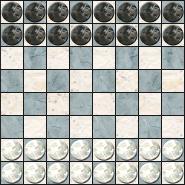Games
Crossings Rules
Overview
Crossings is a two-player game where the player who moves the most pieces to the opposite edge of the board wins. You try to win by maneuvering your pieces to the opposite edge of the board while evading capture and blocking your opponent's freedom to move toward your board edge.
Board
The standard Crossings board size is 8x8. Igfip™ supports a range of smaller and larger board sizes as well as rectangular boards and obstructed spaces.

Even though the standard board size is 8x8, you may find that using a larger board provides more strategic depth. A larger board, combined with a few carefully placed obstructions, creates more engaging game play.
Pieces
Each player starts with a number of pieces equal to twice the number of board columns (e.g., 16 pieces on an 8x8 board). This number changes throughout the game as a result of captures. A player's pieces start the game filling up the first two board rows on the player's side of the board.
Rules
- White moves first.
- A single piece or a contiguous line—orthogonal or diagonal—of pieces may move across a number of empty spaces equal to the number of pieces in the group.
- The direction of movement of a group of pieces must follow the direction created by the line forming the group. Therefore, a single piece may move one space in any direction. But a group of two pieces vertically adjacent may move only forward or backward vertically.
- At the end of a move, if the space adjacent to the group's line of movment is occupied by an opposing piece, the piece is captured and removed from the board only if the number of contiguous opposing pieces along the line of movement is less than the number of pieces in the moving group. If the number of contiguous opposing pieces along the line of movement is greater than or equal to the number of pieces in the moving group, then the move is invalid and cannot be made.
- When a piece reaches the farthest row at the opposite edge of the board (called a crossing), it can no longer be moved or captured and remains in place for the rest of the game.
- After a player makes a crossing, the other player must make a crossing on his next move. If the other player does not do so, he loses the game. If it becomes impossible for either player to lose, the game ends in a draw.
Crossings Help
Legend
| Unselected | Selected or Moved | Moved From | Obstructions |
|---|
Movement
Select a piece by clicking on it. Move a selected piece by clicking on the desired destination. If after selecting a piece, but before completing its turn, you decide to move a different piece, cancel the move by selecting another piece.
Alternatively, drag a piece from its existing position to its destination by placing the mouse cursor on top of the piece and holding the mouse button down while moving it. Cancel a move by dragging the piece back to its original location before releasing the mouse button.
More on Movement
When you select a piece, it is considered the lead element of the group of pieces you intend to move. The size of the group that is moved is calculated from the number of spaces you move. The members of the group are determined from the direction of movement. Therefore, there is no need to specify separately the size of a group or its precise members.
Redraw Board
If you make an adjustment to your Web browser—such as changing your font size—while playing, the game pieces may no longer align correctly with the board. To restore proper alignment, select the Redraw command from the Crossings menu.©2011 Savarese Software Research Corporation
Igfip™ is a trademark of Savarese Software Research Corporation.